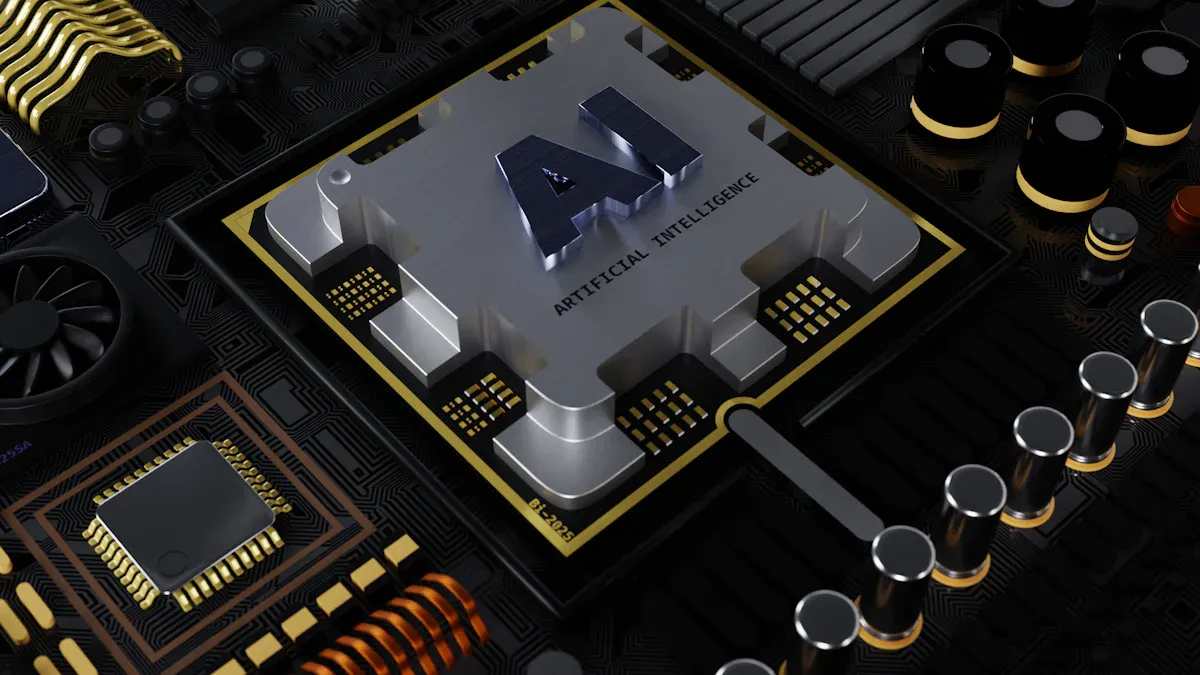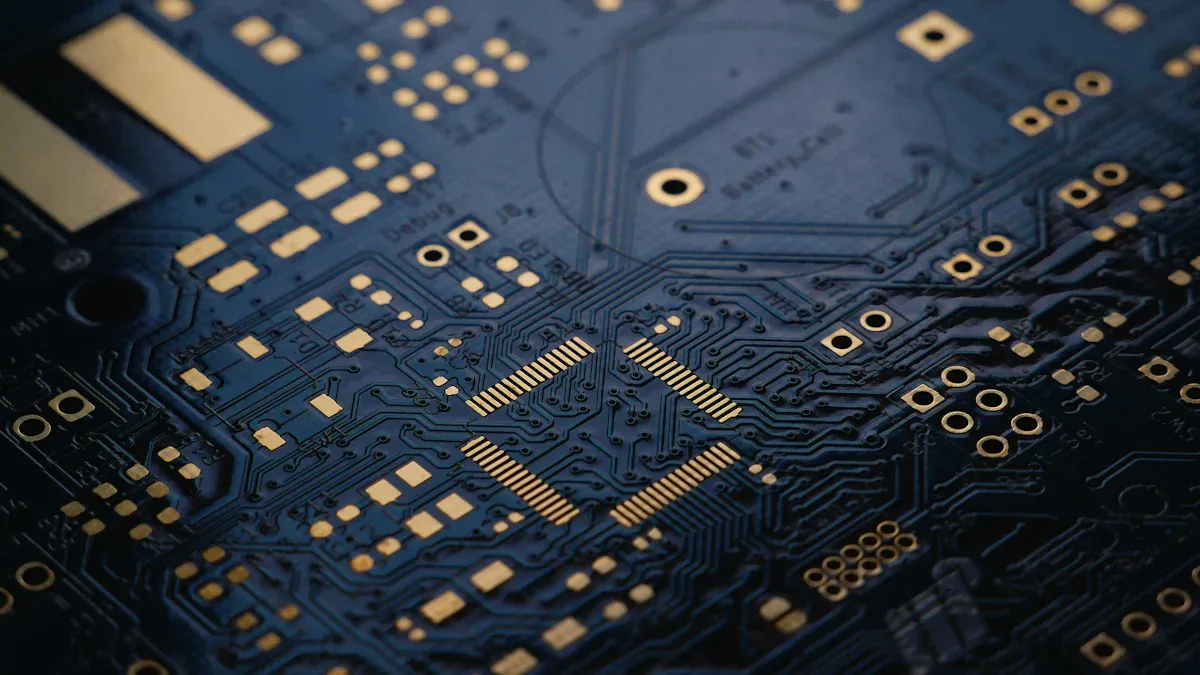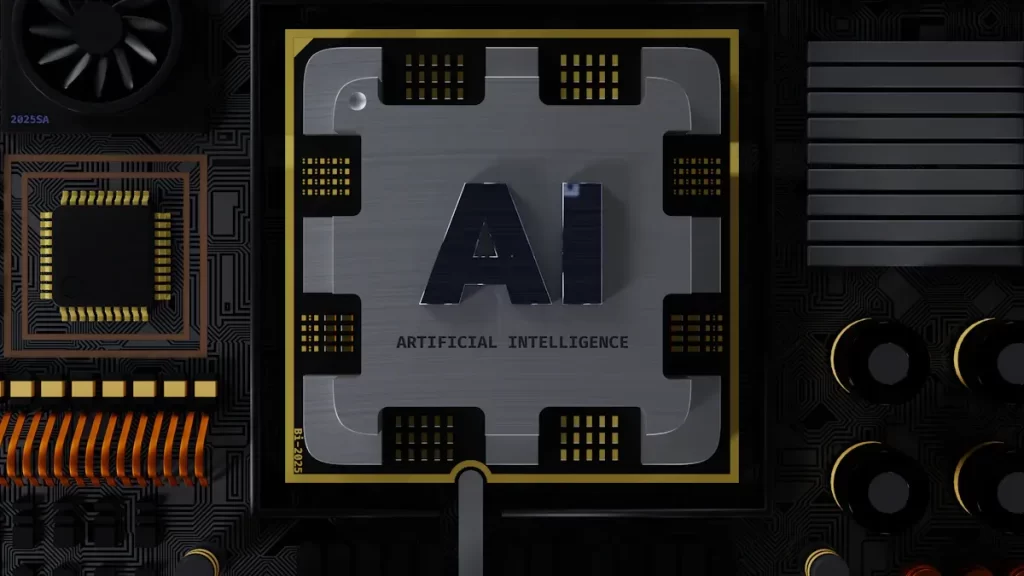
Artificial intelligence (AI) is changing how PCBA for AI is done. It helps manufacturers work faster and more accurately. AI tools pick better parts, cutting BOM costs by 25%. They also speed up PCB design by 40%, making production quicker. A $50 billion communications company used AI to find defects humans missed. This improved product quality and saved time.
People want smarter and more reliable gadgets. This is making AI more popular. Predictive maintenance helps prevent breakdowns. AI also makes it easier to assemble tiny parts on boards. These changes make PCBA for AI very important for modern electronics.
Key Takeaways
AI helps PCBA by doing tasks automatically, making work faster, and improving quality.
AI tools can save 25% of costs and cut production time by 40%, making factories work better.
AI-powered predictive maintenance stops machines from breaking, keeping them running longer and smoother.
AI finds 30% more defects, making products more reliable and with fewer errors.
Using AI in PCBA allows unique designs, helping products be special in a tough market.
PCBA for AI: Basics and Integration
What is PCBA, and why is it important?
PCBA stands for Printed Circuit Board Assembly. It is the heart of modern electronics. It links and holds parts together so devices work well. Without PCBA, gadgets would not be as advanced or precise. PCBA is used in things like phones and medical tools. It combines parts into small, reliable systems, making complex devices possible.
PCBA helps make production faster and better. It speeds up steps from design to assembly. This keeps product quality high and customers happy. As people want smaller and faster gadgets, PCBA becomes even more important in making electronics.
How artificial intelligence integrates into PCBA processes
AI is changing how PCBA works. It automates tasks like finding defects and checking data. AI spots problems faster than old methods, saving time. This boosts production speed and improves product quality.
AI also helps design better electronics. Tools like AI chatbots guide PCB layouts and designs. AI models check electrical signals to improve device performance. These tools make sure AI-powered devices work better.
Small and strong PCBA designs are great for AI. For example, power boards with safety features keep AI systems safe. These examples show how AI fits into PCBA processes.
Transitioning from traditional methods to AI-driven approaches
Switching to AI from old PCBA methods has big benefits. Old ways depend on manual checks, which take time and can have mistakes. AI fixes this by automating tasks and giving instant updates.
Real-life examples show this change. A former SpaceX engineer, Sergiy Nestorenko, used AI to improve PCB design. This shows how AI can make manufacturing faster and more accurate. Using AI means quicker production, lower costs, and better products.
AI-based PCBA also allows custom designs. You can create designs for specific needs in electronics. This helps your products stay ahead in a fast-changing market.
AI-Driven Innovations in PCBA

AI-powered design optimization
AI has changed how PCBA designs are made. AI tools help improve layouts, fix mistakes, and boost performance. These tools study designs and suggest better ways to build them. This saves both time and materials. For example, AI can arrange circuits to use space wisely. It also checks for problems before production starts, avoiding costly errors.
AI makes smaller, faster, and energy-saving devices possible. Tools like AORUS AI SNATCH make CPUs and DDR5 work 20% better. AI-VIA reduces signal loss by 28%. These tools show how AI improves PCBA designs. They help create better electronics and stay ahead in the market.
Predictive maintenance for efficient operations
AI helps keep PCBA machines working well. It studies data from sensors to predict when repairs are needed. This stops machines from breaking down suddenly. Fixing problems early makes machines last longer and work better. For example, sound and vibration checks find issues before they get worse.
Real-time data is also important. Reports show defect patterns, helping you fix problems faster. Root-cause analysis finds what causes issues, improving production. Predictive maintenance keeps quality high and saves money. It makes your work smoother and more reliable.
Automated quality control and defect detection
AI has improved how defects are found in PCBA. Old methods missed small problems, but AI finds them easily. AI systems keep learning and get better over time. For example, one company saved $2 million a year by catching 30% more defects. Another company found 95% of defects, improving production by 15%.
AI speeds up inspections and reduces mistakes. It lowers false rejections by 30%, so only good parts move forward. This is very important for industries like cars and planes, where safety matters most. Using AI for quality checks saves time, cuts waste, and makes better products.
Machine learning for better PCBA processes.
Machine learning is changing PCBA by making it faster and easier. It uses smart programs to study data, guess results, and do tasks. This helps make more products with better quality.
A big advantage of machine learning is better circuit design. It looks at design limits and needs, then suggests better layouts. These layouts make devices work well and are easier to build. This helps meet what customers want.
Machine learning also improves automation. Robots like pick-and-place machines use it to handle parts better. They adjust for part differences and spot mistakes. This reduces waste and makes work more accurate. For example, PCBAIR uses machine learning and heat cameras to find problems early. This keeps quality high in important fields like healthcare and space.
It also helps with predictive maintenance. By studying sensor data, it knows when machines might break. Repairs are planned before problems happen, saving time and money. Machine learning also helps manage supplies by guessing needs and planning deliveries. This makes the whole process smoother.
With machine learning in PCBA, every step works better. It saves time, cuts costs, and helps make reliable products faster.
Real-World Applications in Consumer Electronics

AI-enhanced PCBA in smart devices and wearables
AI has changed how PCBA helps smart gadgets and wearables. Now, devices are smaller and work better with cool features. AI tools design circuits to fit into tiny devices like smartwatches. These tools also help keep devices cool while they work.
AI-powered PCBA improves how devices connect with each other. For example, AI organizes circuit paths for better communication. It also speeds up making new products, so companies can sell them faster.
The role of AI in IoT and efficient IoT sensor networks
AI is very important for improving IoT devices. With AI, PCBA makes sensor networks work better by placing sensors smartly. These networks need good circuits to send data without problems. AI helps design these circuits, reducing mistakes and saving time.
In IoT gadgets, AI automates tasks like checking for defects. This keeps devices working well and lowers errors. AI also helps manage supplies, avoiding waste and shortages. These changes make IoT devices cheaper and more dependable.
Applications in healthcare electronics and medical devices
AI-powered PCBA has improved medical devices, making them more accurate. AI helps design circuits that give better signals for doctors. This helps doctors find health problems faster and easier.
AI also makes building medical devices quicker. For example, it helps manage heat in devices like monitors. Predictive maintenance, using AI, keeps machines working well, ensuring top-quality products.
AI also connects medical devices for better patient care. These systems use smart sensors to collect and study data. This helps doctors monitor patients and improve treatments.
Benefits of AI in PCBA
Cost efficiency and waste reduction
AI helps save money and cut down waste in PCBA. It automates tasks, making production faster and smoother. For example, AI systems reduce material waste and extra costs. This means you can make more products while spending less.
Here’s how AI improves cost efficiency in PCBA:
Benefit | Description |
|---|---|
Increased Efficiency | Speeds up production by automating repeated tasks. |
Reduced Costs | Cuts waste and lowers manufacturing expenses. |
Enhanced Worker Safety | Handles dangerous tasks, keeping workers safe. |
These changes save money and make production eco-friendly. With AI, you get better results using fewer resources.
Improved reliability and product quality
AI makes sure your products are high-quality. Automated systems find defects people might miss. This means fewer mistakes and better electronics. For example, AI spots tiny flaws in PCBA, ensuring devices work perfectly.
AI also improves device security. It checks data in real time to find weak spots. This helps create safe and reliable electronics. Whether it’s a smartwatch or smart home gadget, AI ensures they work well and stay secure.
Faster production cycles and time-to-market
AI speeds up production, helping you launch products faster. A medical company cut production time by 40% using AI tools. This shows how AI can improve timelines.
AI also predicts machine problems before they happen. It uses sensor data to avoid sudden breakdowns. This keeps production running smoothly. Faster production means you can meet demand for new technology quickly.
AI also customizes designs to fit specific needs. This helps create unique electronics that stand out. With speed, quality, and custom designs, AI keeps your products ahead of others.
Personalization in consumer electronics.
AI has changed how gadgets fit your needs. Devices now have features made just for you. This makes them easier and more fun to use. AI helps gadgets learn about you, making them smarter.
Phones are a great example. AI powers tools like face unlock and voice helpers. These tools learn what you like and how you use your phone. For example, your phone might suggest apps you use often. This saves time and makes tasks simpler.
In smart homes, AI makes life easier. Smart thermostats and lights adjust to your habits. They know when you wake up or go to bed. This keeps your home comfy without you doing anything.
Wearables also use AI to help you. Fitness trackers and smartwatches check your health and give tips. They study your heart rate, sleep, and activity. Then, they suggest ways to stay healthy and reach your goals.
Even entertainment is more personal now. Apps like Netflix and Spotify use AI to learn what you like. They suggest shows, movies, or songs you’ll enjoy. This makes finding something fun super easy.
AI makes gadgets feel like they know you. By learning from you, they create helpful and personal experiences.
The Future of AI in PCBA
New trends in AI and PCBA working together
AI is bringing big changes to PCBA and electronics. By 2025, robots will do most factory work. These robots will be very accurate, making fewer mistakes. Machines will check products faster while keeping quality high. Smart programs will suggest where to place parts, improving every step.
You’ll also see cool ideas like combining parts into one package. This makes devices work better and use less power. 3D chips will save space and work faster. These are great for things like virtual reality. These trends show how AI is changing how electronics are made.
AI helping eco-friendly manufacturing
AI isn’t just fast; it helps the planet too. It studies data to find ways to be greener. For example, Amazon uses AI to use less packaging. In PCBA, AI reduces waste and saves energy.
New methods like low-heat processing and recycling are becoming normal. AI makes these processes easier. Companies are also using materials that break down naturally. These changes help make electronics without hurting the environment. By doing this, we can meet the need for green gadgets.
Cool ideas shaping future electronics
AI will make future gadgets even better. Faster memory will help with virtual reality. New cooling systems will keep devices working well under pressure.
Factories will use more robots and AI to work faster and better. This will make products cheaper and higher quality. You’ll get smarter gadgets that fit your needs. AI is leading the way to amazing new technology that will change how we use electronics.
AI has changed how PCBA works in consumer electronics. It improves connections, makes car electronics safer, and cuts waste. For example, Tesla uses AI to design better PCBs for electric cars. Chip companies also use AI to lower waste during production.
Using AI gives you an advantage. AI systems are faster and better than old methods. They find defects, work quickly, and adapt easily. This helps make products faster and meet market needs.
In the future, AI will keep improving things. It will help make greener factories and smarter gadgets that change how we live.
Table: How AI Improves PCBA
Area of Impact
How AI Helps
Example/Application
Connection Design
Predicts and fixes problems for better performance.
AI tools in 5G and communication devices.
Car Electronics
Makes designs safer and more reliable for cars.
Tesla and Bosch using AI for electric cars.
Green Manufacturing
Finds recyclable materials and lowers waste.
Chip companies cutting waste with AI.
Fast Prototyping
Speeds up design and finds problems early.
AMD using AI for high-speed PCB designs.
Signal Control
Fixes signal issues for better device performance.
RF PCB makers improving 5G devices.
Flexible PCB Design
Tests materials and improves designs for flexible gadgets.
AI tools for wearables and medical devices.
FAQ
What is PCBA, and how does AI improve it?
PCBA means Printed Circuit Board Assembly. It links parts to make devices work. AI helps by automating jobs, finding flaws, and improving designs. This saves time, cuts costs, and makes better products.
How does AI help with defect detection in PCBA?
AI uses smart programs to spot flaws missed by people. It checks pictures and data quickly for accurate results. This lowers mistakes, boosts reliability, and speeds up quality checks.
Can AI make PCBA more eco-friendly?
Yes! AI reduces waste by using materials wisely and working efficiently. It also supports recycling and energy-saving methods. These changes help make greener factories and protect the planet.
Is AI in PCBA suitable for small-scale manufacturers?
Yes! AI tools can fit small businesses too. They help with design and finding flaws. This improves work, saves money, and helps small companies compete.
What industries benefit most from AI-enhanced PCBA?
AI-enhanced PCBA helps electronics, healthcare, cars, and IoT. It makes products better, faster, and smarter. For example, AI improves smartwatches, medical tools, and electric car parts.
Tip: Try AI tools now to stay ahead in electronics!
See Also
Innovations in RSJPCBA Design and Assembly Through AI
How to Choose the Right PCBA Manufacturer for You
Guide to Assembling PCBA While Avoiding Common Mistakes





